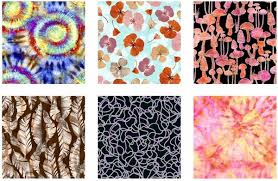The Art of Textile Designs
Textile designs play a crucial role in the world of fashion and interior design, adding personality, style, and visual interest to fabrics and surfaces. From intricate patterns to bold prints, textile designs are a form of artistic expression that can transform everyday objects into works of art.
One of the most fascinating aspects of textile design is the endless possibilities it offers for creativity and innovation. Designers can draw inspiration from nature, culture, history, and contemporary trends to create unique patterns that evoke different emotions and tell stories through their designs.
Textile designers often use a variety of techniques such as digital printing, screen printing, embroidery, and weaving to bring their designs to life on fabrics. Each technique offers its own set of challenges and opportunities for experimentation, allowing designers to push the boundaries of traditional textile design and create cutting-edge pieces that captivate audiences.
Furthermore, textile designs are not limited to just clothing and home decor. They can also be applied to accessories, upholstery, wallpapers, and even art installations, showcasing the versatility and adaptability of this art form.
Whether it’s a timeless floral pattern on a dress or a modern geometric print on a cushion cover, textile designs have the power to enhance our surroundings and elevate our everyday experiences. They remind us that art is not confined to galleries but can be woven into the fabric of our lives in unexpected and delightful ways.
In conclusion, textile design is a dynamic and vibrant field that continues to evolve with each passing season. It celebrates creativity, craftsmanship, and individuality while enriching our world with beauty and style. Next time you admire a beautifully designed fabric or garment, take a moment to appreciate the artistry behind it and the stories it conveys through its intricate patterns and colors.
Exploring the World of Textile Design: Definitions, Product Design, Patterns, and Examples
- What is meant by textile design?
- What is textile product design?
- What is a textile pattern?
- What are examples of textile design?
What is meant by textile design?
Textile design refers to the art and process of creating patterns, textures, and structures on fabrics through various techniques such as printing, weaving, knitting, and embroidery. It involves the manipulation of fibers and surfaces to produce visually appealing designs that can be used in fashion, home decor, and other applications. Textile designers carefully consider color schemes, motifs, and compositions to convey a particular aesthetic or message through their creations. Ultimately, textile design is about transforming plain fabrics into dynamic works of art that enhance our surroundings and reflect the creativity and skill of the designer.
What is textile product design?
Textile product design refers to the process of creating innovative and functional textile-based products that serve both aesthetic and practical purposes. It involves the integration of artistic vision, technical expertise, and market understanding to develop textiles that not only look visually appealing but also meet the specific needs and requirements of consumers. Textile product designers often collaborate with manufacturers, engineers, and marketing teams to bring their ideas to life, ensuring that the final products are not only beautiful but also durable, sustainable, and commercially viable in today’s competitive market.
What is a textile pattern?
A textile pattern refers to a decorative design or motif that is repeated on fabric surfaces to create visual interest and texture. These patterns can range from simple geometric shapes to intricate floral designs, and they play a crucial role in enhancing the aesthetic appeal of textiles used in clothing, home decor, and other applications. Textile patterns are often created through techniques such as printing, weaving, or embroidery, and they can convey cultural traditions, artistic expressions, or simply add a touch of personality to the fabric. Understanding different textile patterns allows designers and consumers to appreciate the artistry and craftsmanship behind each piece of fabric and explore the diverse world of textile design.
What are examples of textile design?
Textile design encompasses a wide range of styles and techniques that showcase the creativity and artistry of designers. Examples of textile designs include traditional patterns like paisley, damask, and ikat, which have been passed down through generations and continue to inspire contemporary creations. Modern textile designs often feature bold geometric prints, abstract motifs, floral patterns, and whimsical illustrations that reflect current trends in fashion and interior design. From intricate handwoven textiles to digitally printed fabrics, the world of textile design offers a diverse array of examples that demonstrate the endless possibilities for artistic expression through textiles.

